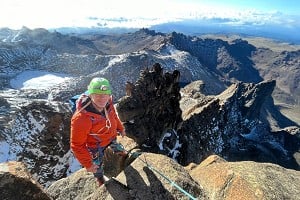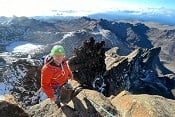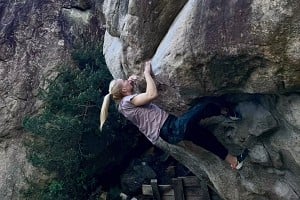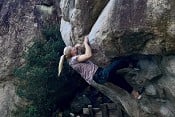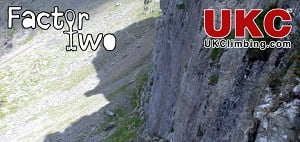
This topic has been archived, and won't accept reply postings.
I bought some of the £6 needlesports quickdraws and they have two straight wire-gate biners on a sling. One of the biners is loose on the sling and the sling is sewen at the other end just below the biner(as with most quickdraws).
My question is; does it matter if the loose biner is on the rope and the sewen biner on the pro or the other way round?
Cheers Andy
My question is; does it matter if the loose biner is on the rope and the sewen biner on the pro or the other way round?
Cheers Andy
In reply to AndyH1710:
You wanna be using the sewn end for clipping the rope through.
Not only is this end easier to clip, but if clipping a krab through bolts, wires or pegs the metal can get rough edges on it, so you always wanna be using the one end for the gear & one for the rope.
You wanna be using the sewn end for clipping the rope through.
Not only is this end easier to clip, but if clipping a krab through bolts, wires or pegs the metal can get rough edges on it, so you always wanna be using the one end for the gear & one for the rope.
In reply to AndyH1710: the sewen in end goes on to the rope and the lose end on the hardwear. this holds the rope in a better way.
In reply to AndyH1710: The end you clip to your gear is the loose end i believe. This is to stop gear from either walking in (in the case of cams) or been lifted out etc.
In reply to Laurie Rogerson:
does it make a difference either way?
surely there's the same amount of give in the system, which ever way it's clipped?
agree about the one end for rop one for gear business though, i just use the sewn end for gear
GTE
does it make a difference either way?
surely there's the same amount of give in the system, which ever way it's clipped?
agree about the one end for rop one for gear business though, i just use the sewn end for gear
GTE
In reply to G. Tiger, Esq.:
Yes. If the end attached to the gear is fixed, then any pivoting motion applied by the rope will apply force to the gear, potentially lifting it out. If the gear end is loose, then the sling moves and not the krab.
I haven't explained that very well, but if you try it out then you'll see what I mean!
> does it make a difference either way?
Yes. If the end attached to the gear is fixed, then any pivoting motion applied by the rope will apply force to the gear, potentially lifting it out. If the gear end is loose, then the sling moves and not the krab.
I haven't explained that very well, but if you try it out then you'll see what I mean!
In reply to Simon Caldwell:
suerly that would happen at the other end of teh quickdraw instead on account of the krab not being sewn iinto the sling
GTE
suerly that would happen at the other end of teh quickdraw instead on account of the krab not being sewn iinto the sling
GTE
In reply to G. Tiger, Esq.: No, If you consider the use of a quickdraw, one end is in a piece of gear, the other is on the rope.
Now imagine the rope is moved to the side:
If the fixed end is attached to the gear, movement of the rope will pull the sling across, which will cause the karibiner to rotate, potentially moving your gear.
If the loose end is attached to the gear, movement of the rope will still pull the sling across, but it will not (or is less likely to) affect the karibiner attached to the gear, so is safer.
Also one of the karibiners will probably have a bent gate: this is to enable it to clipped to the rope more easily
Now imagine the rope is moved to the side:
If the fixed end is attached to the gear, movement of the rope will pull the sling across, which will cause the karibiner to rotate, potentially moving your gear.
If the loose end is attached to the gear, movement of the rope will still pull the sling across, but it will not (or is less likely to) affect the karibiner attached to the gear, so is safer.
Also one of the karibiners will probably have a bent gate: this is to enable it to clipped to the rope more easily
In reply to Laurie Rogerson:
No the fixed end is the one you use for the gear. The loose end is the one you use for the rope. This then reduces the risk of the rope lifting any gear out.
> (In reply to AndyH1710) The end you clip to your gear is the loose end i believe. This is to stop gear from either walking in (in the case of cams) or been lifted out etc.
No the fixed end is the one you use for the gear. The loose end is the one you use for the rope. This then reduces the risk of the rope lifting any gear out.
In reply to Allan Thomson:
So why were DMM Mambas produced with the fixed end at the bent gate krab which is obviously the end for the rope?
Bob
So why were DMM Mambas produced with the fixed end at the bent gate krab which is obviously the end for the rope?
Bob
In reply to Allan Thomson:
Sorry Allan, that's completely incorrect.
Horses for courses though eh? You clip 'em as you see fit mate!
Sorry Allan, that's completely incorrect.
Horses for courses though eh? You clip 'em as you see fit mate!
In reply to Bob, Jus and 5.10 Ken:
So explain why exactly on my Wild country wiregates, the Krab for the rope (Red - logic would suggest manufacturers inteded Red for Rope anyway that's the way I always remember) is loose, while the Krab for the gear (Grey - for Gear) is fixed? if the sling is hanging downwards, then as the rope krab is lifted it wants to be able to slide up and down the sling and reduce the actual movement of the sling. I also seem to remember reading or being told somewhere that it was fixed for gear and loose for rope.
Though I could see why it the reverse could also be true, as a loose sling on the gear end would allow it to pivot without transmitting movement the gear. And fair enough on another brand of quickdraws I own, the bent gate is on the fixed end.
So explain why exactly on my Wild country wiregates, the Krab for the rope (Red - logic would suggest manufacturers inteded Red for Rope anyway that's the way I always remember) is loose, while the Krab for the gear (Grey - for Gear) is fixed? if the sling is hanging downwards, then as the rope krab is lifted it wants to be able to slide up and down the sling and reduce the actual movement of the sling. I also seem to remember reading or being told somewhere that it was fixed for gear and loose for rope.
Though I could see why it the reverse could also be true, as a loose sling on the gear end would allow it to pivot without transmitting movement the gear. And fair enough on another brand of quickdraws I own, the bent gate is on the fixed end.
In reply to Allan Thomson:
According to the (nice to look at but awful to read) WC website you are right in that red is for rope and silver/grey is for gear. I couldn't see or read anything that mentioned either end being fixed.
The bent gate should always be at the rope end, but it would appear that which end is fixed is up to the manufacturer.
Bob
According to the (nice to look at but awful to read) WC website you are right in that red is for rope and silver/grey is for gear. I couldn't see or read anything that mentioned either end being fixed.
The bent gate should always be at the rope end, but it would appear that which end is fixed is up to the manufacturer.
Bob
In reply to Bob:
Just thought about it a bit more though, and I do remember reading somewhere that the rope end should be fixed in order to stop the crab rotating when the rope moves (to stop the gate getting loaded in event of a fall. (have actually just swapped all my QD's Krabs around after thinking that so I still have Red for rope, and grey for gear, but with the rope end fixed now).
Both My DMM's and my WC's had the grey crab fixed, while the red or plain was loose. On the other hand my Field and Trek's were the opposite with the bent gate on the fixed and the straight loose. Definitely agree with you about using bent for rope, and straight for gear, no doubt about that.
Wonder why there is this manufacturers difference? Would have thought if it was for safety reasons, there would be a standard practice in which end is fixed.
Just thought about it a bit more though, and I do remember reading somewhere that the rope end should be fixed in order to stop the crab rotating when the rope moves (to stop the gate getting loaded in event of a fall. (have actually just swapped all my QD's Krabs around after thinking that so I still have Red for rope, and grey for gear, but with the rope end fixed now).
Both My DMM's and my WC's had the grey crab fixed, while the red or plain was loose. On the other hand my Field and Trek's were the opposite with the bent gate on the fixed and the straight loose. Definitely agree with you about using bent for rope, and straight for gear, no doubt about that.
Wonder why there is this manufacturers difference? Would have thought if it was for safety reasons, there would be a standard practice in which end is fixed.
In reply to Allan Thomson:
The DMM Mamba comes in two flavours: One has a single, bent gate, fixed krab to which you add your own straight gate; the other has both krabs fixed.
Petzl used to (still do?) sell tie-offs with a device that looked like a miniature pair of shorts with which you fixed one krab. From the literature that came with them I am fairly certain that it was the krab at the rope end. Certainly that is how all mine are done.
Probably as much a marketing thing - I would have thought that having a narrow sling with both krabs loose would allow either to turn as needed.
Bob
The DMM Mamba comes in two flavours: One has a single, bent gate, fixed krab to which you add your own straight gate; the other has both krabs fixed.
Petzl used to (still do?) sell tie-offs with a device that looked like a miniature pair of shorts with which you fixed one krab. From the literature that came with them I am fairly certain that it was the krab at the rope end. Certainly that is how all mine are done.
Probably as much a marketing thing - I would have thought that having a narrow sling with both krabs loose would allow either to turn as needed.
Bob
In reply to Bob:
I thought that the reason the rope end was fixed was to stop the krab rotating around - if that happens then a fall would pull the rope tight over the gate, opening it with quite worrying consequeces...
As fas as I've ever seen or read, fixed end and bent gates clip to the rope...
(btw, I'm npt impressed by the Needlesports solid gate krabs - seem too stiff for me, probably as the bar needs a strong spring to keep it shut properly. Is that a general feature with solid gates, or are these ones just unusually stiff?)
I thought that the reason the rope end was fixed was to stop the krab rotating around - if that happens then a fall would pull the rope tight over the gate, opening it with quite worrying consequeces...
As fas as I've ever seen or read, fixed end and bent gates clip to the rope...
(btw, I'm npt impressed by the Needlesports solid gate krabs - seem too stiff for me, probably as the bar needs a strong spring to keep it shut properly. Is that a general feature with solid gates, or are these ones just unusually stiff?)
In reply to psd:
No idea as to the Needlesport krabs. I've no direct experience of wire-gate krabs as I haven't had need to buy any krabs for several years so can't really compare them. However I would not have thought that the spring for either would be stronger or weaker.
Bob
No idea as to the Needlesport krabs. I've no direct experience of wire-gate krabs as I haven't had need to buy any krabs for several years so can't really compare them. However I would not have thought that the spring for either would be stronger or weaker.
Bob
In reply to Bob:
Well, one of the advantages of wiregates is that the gate is lighter, so less prone to whiplash - which should in turn mean it doesn't need to be s stiff for the same safety margin, I think?
Well, one of the advantages of wiregates is that the gate is lighter, so less prone to whiplash - which should in turn mean it doesn't need to be s stiff for the same safety margin, I think?
In reply to AndyH1710: On another note I tend to make up my own quickdraws using around a 20-30cm extenders I have around 10 using extnders and 10 standerd quickdraws. the extenders are loose at both ends but i use silver for gear and color for rope. I tend to prefure using the extenders as this gives more flexability in the running of the rope and does not strain the gear. The question is should one end be fixed or is it ok to use extenders loose at both ends.
In reply to Bob:
you can get the little rubber petzel tie offs at http://www.needlesports.com/acatalog/Mail_Order_Slings___Extenders_21.html
and scroll down a bit
you can get the little rubber petzel tie offs at http://www.needlesports.com/acatalog/Mail_Order_Slings___Extenders_21.html
and scroll down a bit
In reply to Removed User:
I modified my needlesports quickdraws in exactly the same way for climbing outdoors. I prefer to leave both krabs 'loose' as it makes them easier to rotate into the best orientation, and prevents the extender lifting.
I think most quickdraws have the rope end krab fixed these days purely to make clipping the rope easier, rather than for any safety reason.
I modified my needlesports quickdraws in exactly the same way for climbing outdoors. I prefer to leave both krabs 'loose' as it makes them easier to rotate into the best orientation, and prevents the extender lifting.
I think most quickdraws have the rope end krab fixed these days purely to make clipping the rope easier, rather than for any safety reason.
In reply to Removed User:
I also use different sizes of extenders to mix depending on what I'm climbing, consequently krabs are loose at both ends, which has been a bit annoying and fiddly at times when trying to clip. Richard of orange (house that is) said as a cheap way of fixing one end was to cut old bike inner tube to make strong elastic bands then fit them to one krab.
Cheap as chips
Bren
I also use different sizes of extenders to mix depending on what I'm climbing, consequently krabs are loose at both ends, which has been a bit annoying and fiddly at times when trying to clip. Richard of orange (house that is) said as a cheap way of fixing one end was to cut old bike inner tube to make strong elastic bands then fit them to one krab.
Cheap as chips
Bren
In reply to Brinner:
Just as cheap are castrating rings - you know those little orange rubber bands that you see lying around in fields. You have to remove the tails or what have you first mind!
Bob
Just as cheap are castrating rings - you know those little orange rubber bands that you see lying around in fields. You have to remove the tails or what have you first mind!
Bob
You could also use hair bobbles. I put some I'd get ages ago whenI used to have long hair to good use last week when making my own quickdraws.
In reply to AndyH1710:
I always use the "fixed" end for the rope, it stops the krab moving around while I'm trying to clip it.
But isn't it slightly alarming that no one seems able to agree on this? The people on this forum all seem to have worked out a system for themselves, the trouble is both methods have a certain logic to them. The gear designers presumably have a reason for fixing one end, but they don't seem to have done a very good job of communicating it to the masses. How about some guidance from the manufacturers?
I always use the "fixed" end for the rope, it stops the krab moving around while I'm trying to clip it.
But isn't it slightly alarming that no one seems able to agree on this? The people on this forum all seem to have worked out a system for themselves, the trouble is both methods have a certain logic to them. The gear designers presumably have a reason for fixing one end, but they don't seem to have done a very good job of communicating it to the masses. How about some guidance from the manufacturers?
In reply to Howard:
That's just it! One manufacturer does it one way another does it the other way. So there is no clear indication as to which is correct or indeed if the opposite way is, in any way, dangerous.
Bob
That's just it! One manufacturer does it one way another does it the other way. So there is no clear indication as to which is correct or indeed if the opposite way is, in any way, dangerous.
Bob
In reply to Bob:
Hmm, maybe it is just a preference thing then, with no real gain either way? You can buy extenders that are open at both ends, so maybe it's not that important and comes down to preference?
Hmm, maybe it is just a preference thing then, with no real gain either way? You can buy extenders that are open at both ends, so maybe it's not that important and comes down to preference?
In reply to Bob:
Don't forget Bob that QDs were originally designed for sport routes where the bolt is fixed. They also only used to make short ones till some of us rabbited on about them being unsuitable for trad on a lot of routes due to lifting out. Now you have three lengths to buy from, but still in some cases with fixed krabs on one end.
Horses for courses, and a bit of thought placing your runners aint it?
Don't forget Bob that QDs were originally designed for sport routes where the bolt is fixed. They also only used to make short ones till some of us rabbited on about them being unsuitable for trad on a lot of routes due to lifting out. Now you have three lengths to buy from, but still in some cases with fixed krabs on one end.
Horses for courses, and a bit of thought placing your runners aint it?
In reply to Allan Thomson:
Well my WC Helium quick draws have the red end fixed and the silver end free. So lloks like WC aren't that consistant about these things! But given that they have just recalled my 'draws maybe this is not a good example!
Andy
Well my WC Helium quick draws have the red end fixed and the silver end free. So lloks like WC aren't that consistant about these things! But given that they have just recalled my 'draws maybe this is not a good example!
Andy
I think you'll find that quickdraws evolved from the need to carry extension slings pre-clipped for wires on trad routes (remember these), prior to bolt clipping becoming a popular pastime! 'Quickdraws' became the accepted name for these extensions and they were naturally switched for use on bolted routes when these started to appear. Sewn together versions (dogbones) were the next development - to hold the krabs in place to facilitate cleaner clipping. (This is when bent gates started to appear as well for easier location of the rope when clipping in). Because dogbones tended to prevent the bolt-end krab from settling in its natural orientation in some cases with a risk of twisting the gate open, open loop slings regained favour to allow for freer rope movement. However, it is still favourable to keep the rope end krab fixed the right way round for easy clipping (even for trad wires) hence the current trend. Bear in mind that the folks who clip the krabs on the slings at the factory are probably not climbers - that's your job!
This topic has been archived, and won't accept reply postings.
Loading Notifications...

